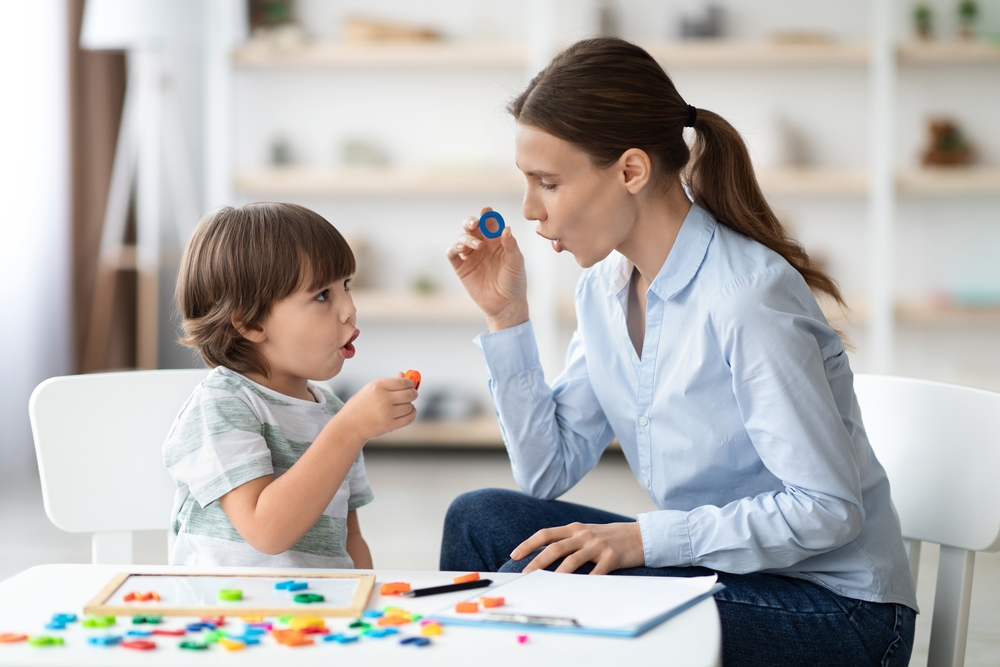
Receptive language is a foundational component of communication that refers to the ability to understand and process spoken or written language. It encompasses a variety of skills such as interpreting words, sentences, and non-verbal cues, such as body language and facial expressions. Children develop receptive language skills before they express language verbally—that is, their ability to understand language typically precedes their ability to speak it.
The development of receptive language begins in infancy as babies start to recognize familiar voices and sounds. As they grow, they start to comprehend words and eventually sentences, which allows them to follow simple instructions, and understand questions or stories. It’s important to note that receptive language is different from expressive language, which is all about producing language, whether through speech, sign, or writing.
Receptive language skills serve as the foundation for social interaction, educational success, and overall communication. These skills empower children to follow directions, engage in conversations, and extract information from what they hear or read. Without a strong understanding of language, children may struggle with learning and socializing, which can have long-lasting effects on their academic and personal development.
How to Support The Development of Receptive Language
Early childhood is a critical period for language development, and it’s important to understand that how children acquire language skills is vital for fostering an environment conducive to learning.
Through an exploration of the science behind language acquisition and practical classroom techniques, this guide will help to:
- Understand the importance of receptive language in early childhood development.
- Recognize the signs of receptive language development and identify when a child might need additional support.
- Learn about the latest research and theories behind language learning.
- Discover interactive activities and games that promote language comprehension.
- Implement strategies for creating a language-rich environment that encourages receptive language growth.
- Foster stronger communication between children, and between children and adults.
- Gain insights into working with children who have language challenges or come from diverse linguistic backgrounds.

Understanding Receptive Language
Receptive language, in its broadest sense, refers to the ability of individuals to comprehend and interpret the language they receive, whether through listening, reading, or observing. This multifaceted skill involves a range of cognitive processes that include:
- Auditory Processing: The ability to decode and make sense of sounds.
- Visual Processing: For receptive written language and understanding of non-verbal cues.
- Attention and Memory: Sustaining focus on the language input and retaining information.
- Contextual Understanding: Interpreting meaning based on the context or setting.
In the realm of speech, receptive language involves understanding spoken words and sentences, recognizing the intent behind questions, and absorbing the meaning conveyed through tone and inflection. For written language, it entails recognizing words and phrases on the page and comprehending their significance within the broader context of the text.
Role in Cognitive and Social Development
The role of receptive language in cognitive and social development is pivotal. It underpins:
- Learning and Knowledge Acquisition: The ability to understand language is essential for grasping new concepts, following instructions, and engaging with educational material.
- Critical Thinking and Problem-Solving: Comprehending complex information allows children to evaluate, analyze, and devise solutions.
- Social Interaction and Empathy: Understanding what others say and imply builds the foundation for responding appropriately and empathetically in social settings.
- Emotional Regulation: Interpreting others’ language correctly helps children manage their reactions and emotions in various situations.
It’s crucial to note that receptive language is not merely about literal comprehension but also involves grasping idioms, jokes, and sarcasm, which are key for nuanced social interactions.
Through careful nurturing of receptive language skills, children can be guided towards becoming more adept learners and empathetic social beings.
Examples of Receptive Language in Action
Receptive language is often underappreciated because it is less visible than expressive language. However, it’s continually at work, particularly in early childhood settings where the foundation for future learning and interaction is being built. Here are some specific examples and comparisons that illustrate the importance and ubiquity of receptive language in early childhood environments.
Real-World Examples in Early Childhood Settings
Following Directions: One of the most straightforward examples of receptive language in action is when a child follows simple commands, such as “Please put the toy back on the shelf” or “It’s time to wash your hands.” At first glance, this may seem like a simple task, but it involves complex cognitive processes such as auditory processing, memory retention, and the ability to execute a series of actions based on verbal cues.
Story Comprehension: During storytime, children listen and absorb the narrative, an activity that bolsters their understanding of language structures, sequencing, and vocabulary. They might not be able to articulate the story themselves but demonstrate understanding by answering questions about it or making predictions about what might happen next.
Responding to Questions: When educators ask questions, children’s responses are a direct reflection of their receptive language abilities. Whether answering simple yes/no questions or more complex “why” and “how” inquiries, children showcase their capacity to process and comprehend language before verbalizing a response.
Identifying Objects: Another example is when children can point to or identify objects or pictures when named by an educator. This demonstrates their ability to associate spoken words with visual representations, a critical aspect of language development.
Group Activities: During group activities, such as singing songs or participating in circle time, children must listen and understand the words and actions of others to participate correctly. This collective engagement in receptive language helps foster a sense of community and shared understanding among the children.
Comparing Receptive and Expressive Language
To fully appreciate the role of receptive language, it’s helpful to contrast it with expressive language. While receptive language is about input — receiving and understanding messages from others — expressive language is about output — sharing thoughts, feelings, and information with others. Consider the following comparisons:
Understanding vs. Speaking: Receptive language might involve a child understanding a story or instruction, whereas expressive language would involve the child retelling the story or explaining how to carry out the instruction.
Interpretation vs. Expression: When a child listens to a joke and understands the humor, that’s receptive language. When they then tell a joke themselves, that’s expressive language.
Comprehension vs. Production: Reading and understanding road signs is an act of receptive language, while creating a sign with a clear message requires expressive language skills.
In building a supportive learning environment, educators must balance activities that promote both receptive and expressive language. Recognizing the nuances between the two helps educators provide more targeted support, ensuring that children are not only able to express themselves but also fully comprehend the world around them.
Maintaining a healthy development of both receptive and expressive language forms the bedrock of effective communication and should be a central focus in early childhood education.
By expanding on these examples, educators can craft a comprehensive picture of receptive language at work and appreciate its critical role in cognitive and social development in young children.

Nurturing Receptive Language Skills
Receptive language development is a critical aspect of childhood growth, as it lays the foundation for effective communication, social interaction, and cognitive development. Both educators and parents play a significant role in nurturing these skills. Here are some effective strategies and goal-setting tips for fostering receptive language development in young children.
Effective Strategies for Educators and Parents
Modeling Active Listening: Demonstrate active listening by paying full attention when the child is speaking. This models the behavior you expect from them and encourages them to reciprocate when it’s their turn to listen.
Nod, make eye contact, and provide feedback, showing that you value both the content and the act of communication.
Creating Interactive Reading Experiences: Engage in shared reading sessions where you not only read to the child but also ask predictive and inferential questions about the story.
Encourage children to point out objects and characters in illustrations to build their word-object association skills.
Incorporating Play-Based Learning: Use role-playing games to practice following instructions and responding to scenarios, which can increase comprehension and vocabulary in a fun and engaging way.
Provide toys and activities that encourage problem-solving and require children to follow multi-step directions.
Providing a Language-Rich Environment: Surround children with a variety of language inputs: songs, rhymes, conversations, and books. Exposure to rich and diverse language content can significantly boost receptive language abilities.
Label classroom objects and use visual aids to enhance word recognition and comprehension.
Utilizing Repetition and Routine: Repeat songs, stories, and instructions. Repetition helps to reinforce language structures and word meanings.
Establish classroom routines that incorporate language cues, fostering predictability and understanding over time.
Encouraging Social Interaction: Foster play and collaboration among children to promote the understanding of language through social contexts.
Provide opportunities for children to communicate needs and thoughts to peers, enhancing their interpretative skills.
Addressing Individual Needs: Tailor activities to suit the different learning styles and paces of children to ensure that each child can engage fully with language learning opportunities.
Be attentive to signs of language delays or difficulties and adjust strategies accordingly to support those children who may need additional help.
Goal-Setting for Language Development
Effective goal-setting for receptive language development involves establishing clear, achievable targets that cater to the developmental stages of each child. Below are some tips on setting these goals:
Assess Current Level of Understanding: Begin by evaluating the child’s current receptive language skills using age-appropriate assessments or informal observations.
Make note of strengths as well as areas that require improvement to tailor goals effectively.
Set Specific, Measurable Goals: Create goals that are specific and measurable, such as “Child will follow two-step instructions with 80% accuracy by the end of the month.”
Ensure goals are challenging yet attainable, considering the child’s age and individual capabilities.
Develop Incremental Steps: Break down larger goals into smaller, incremental steps that provide a clear pathway toward the desired outcome.
Celebrate small successes along the way to maintain motivation and demonstrate progress.
Involve the Child in the Process: Whenever possible, include the child in goal-setting discussions to give them a sense of ownership and responsibility for their learning.
Use visuals or simple language to communicate the goals and steps to the child.
Regularly Review and Adjust Goals: Monitor progress frequently and adjust goals as needed to ensure they remain relevant and attainable.
Use a variety of methods to gauge progress, such as checklists, anecdotal records, or portfolios of the child’s work.
Foster Collaboration Between Home and School: Encourage consistent communication between educators and parents to ensure goals are reinforced in both settings.
Share strategies and progress updates regularly to maintain a cohesive approach to the child’s receptive language development.
By implementing these strategies and goal-setting tips, educators and parents can work together to bolster receptive language skills in young children, paving the way for successful communication and learning experiences.
Practical Advice for Educators and Parents
When it comes to nurturing receptive language skills in early childhood, the importance of integrating engaging activities and recognizing developmental benchmarks cannot be overstated. Here is an in-depth look at how to achieve this crucial aspect of early education.
Activities and Games to Promote Understanding
To effectively enhance a child’s understanding of language, educators and parents should thoughtfully incorporate activities and games that are both interactive and educational. These should cater to various aspects of receptive language, such as listening comprehension, following instructions, and vocabulary development. The following are some proven activities and games that can be invaluable:
Simon Says: This classic game is not only fun but also an excellent way to practice listening skills and following complex instructions.
Matching Games: Using cards with pictures and words, children can match images to corresponding terms, reinforcing word-object association.
Story Sequencing: After reading a story, ask children to sequence pictures or events from the narrative. It helps in understanding the order of events and narrative structure.
Rhyme Time: Engage children with rhyming activities that enhance phonetic awareness and auditory discrimination.
What’s Missing?: Display a group of items, remove one, and ask children to identify what is missing. This game improves memory and encourages attention to detail.
Each of these activities can be adjusted in complexity to suit the developmental stage of the child, ensuring they remain challenged and engaged.
Tips for Recognizing and Addressing Language Delays
Early recognition of language delays is vital for timely intervention, which can mitigate long-term impacts on learning and socialization. Here are tips to recognize and address these delays:
Monitor Milestones: Keep track of language development milestones. Delays in reaching these can indicate a need for further evaluation.
Observation and Documentation: Regular observation and documenting specific examples of a child’s receptive language can provide evidence if there is a need for concern.
Consistent Engagement: Engage with the child frequently through dialogues and interactive readings to assess their understanding continuously.
Professional Assessment: If a delay is suspected, don’t hesitate to seek a professional assessment from a speech-language pathologist.
Early Intervention Programs: Enroll the child in early intervention programs, which can provide specialized support and resources to address language delays.

Creating an Enriched Language Environment
Apart from activities and recognizing delays, it is also essential to create an environment conducive to language development:
Labeling: Labeling objects in the environment can help children connect words to their corresponding objects, thus expanding their vocabulary.
Diverse Language Exposure: Regularly introduce new words and concepts through stories, songs, and conversations.
Encourage Narration and Description: Ask children to describe their day or a picture, promoting the use of language to convey complex thoughts and stories.
An enriched language environment allows children to absorb language through various interactions and media, providing them with a rich tapestry of words and phrases to learn from.
Conclusion
By combining these activities, tips, and environmental strategies, educators and parents can create a robust framework for developing receptive language skills in young children. Early and proactive engagement in this area ensures that children are equipped with the necessary skills for successful communication and learning experiences as they grow.
Remember, each child is unique, and it is crucial to tailor activities and interventions to their individual needs and learning pace. As part of a comprehensive approach to language development, regular communication between educators, parents, and language specialists is essential to provide consistent and effective support for the child’s learning journey.
FAQ’s
What is receptive language, and why is it essential in early childhood development?
Receptive language refers to the ability to understand and process spoken or written language, including interpreting words, sentences, and non-verbal cues. It’s essential in early childhood development because it lays the groundwork for learning, social interaction, and overall communication.
What is the receptive language definition provided in the guide for early childhood educators?
The receptive language definition given in the guide is the ability of individuals to understand and interpret language that they receive, encompassing auditory and visual processing, attention, memory, and contextual understanding.
How do receptive and expressive language differ according to the guide?
Receptive and expressive language differ in that receptive language is about the understanding of language input from others, while expressive language is concerned with producing and conveying messages to others.
Could you give examples of receptive language activities that might help develop these skills in young children?
Examples of receptive language activities are games like Simon Says to practice following directions, matching games to reinforce word-object association, story sequencing for narrative structure comprehension, rhyming activities, and “What’s Missing?” games for attention to detail.
What does receptive communication entail in the context of childhood development?
Receptive communication involves the various components that constitute receptive language, such as processing and interpreting spoken and written language, and it is critical for cognitive and social development in childhood.

 Español
Español